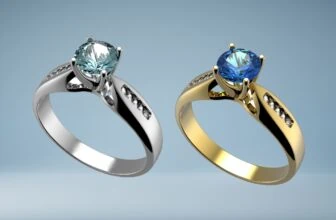
Table of Contents
Labradorite is an instantly recognizable stone with a stunning sheen and gorgeous play of colors. It’s beautiful color and flashes of light are so spectacular that the Inuit people believed that the stone was the Northern Lights captured in the rocks.
Labradorite has been used for centuries in jewelry-making, and is a popular gemstone. It’s growing in popularity as more and more people turn towards spectacular natural gemstones for their jewelry.
If you’re interested in adding this gemstone into your jewelry collection, keep reading! We cover everything you need to know before you buy labradorite.
What is Labradorite?

Labradorite is a member of the plagioclase feldspar group of gemstones and is found in igneous, metamorphic and sedimentary rocks.
It was originally discovered in Labrador, Canada, from where it received its name (and just for the record, it has no connection to the dog breed Labrador). However, today, Madagascar is the most abundant source of labradorite. Some other regions where labradorite is mined are Norway, Finland, Russia, Sri Lanka, and Australia.
Labradorite Varieties
Labradorite is a type of feldspar mineral that’s best known for its iridescent optical effect called labradorescence, which displays vibrant colors when light hits the stone from different angles. Labradorite can be found in various varieties based on its color and where it’s mined. Some of the main varieties include:
1. Spectrolite
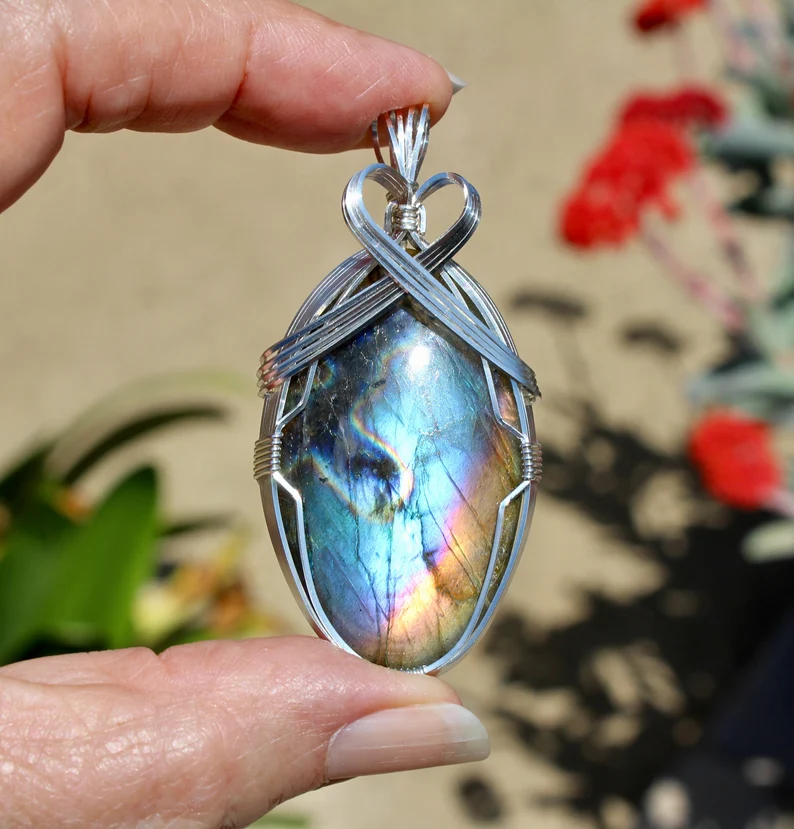
This is a high-quality variety of labradorite discovered in Finland. It’s renowned for showing a full spectrum of colors (hence the name “spectrolite”), including vivid hues of blue, green, yellow, orange, red, and sometimes purple.
2. Andesine-Labradorite

This is a trade name for a red to green gemstone that is a member of the plagioclase feldspar group, which includes both andesine and labradorite. The name was coined to indicate its composition, which lies between andesine and labradorite.
3. Rainbow Moonstone

Even though it’s called “moonstone,” it’s technically a variety of labradorite that displays a blue or multicolored sheen on a light body color. Rainbow moonstone is translucent and usually has a white to clear base.
4. Madagascar Labradorite

This refers to labradorite mined from Madagascar, which can vary widely in its display of colors. Stones from this location are often deeply colored and show strong labradorescence.
5. Transparent Labradorite
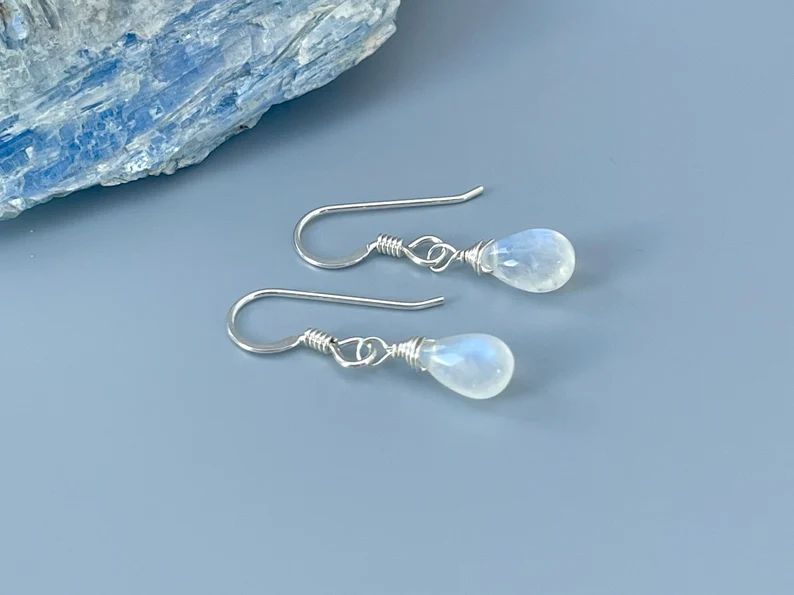
While labradorite is typically a translucent stone, there are transparent varieties that can be faceted (rather than cabochon cut, which is more common for labradorite). These can showcase brilliant colors and have their unique charm.
6. Black Labradorite

This variety usually has a dark base color, almost black, with the colorful sheen overlaying it. This contrast can make the iridescence particularly striking.
What is Labradorescence?
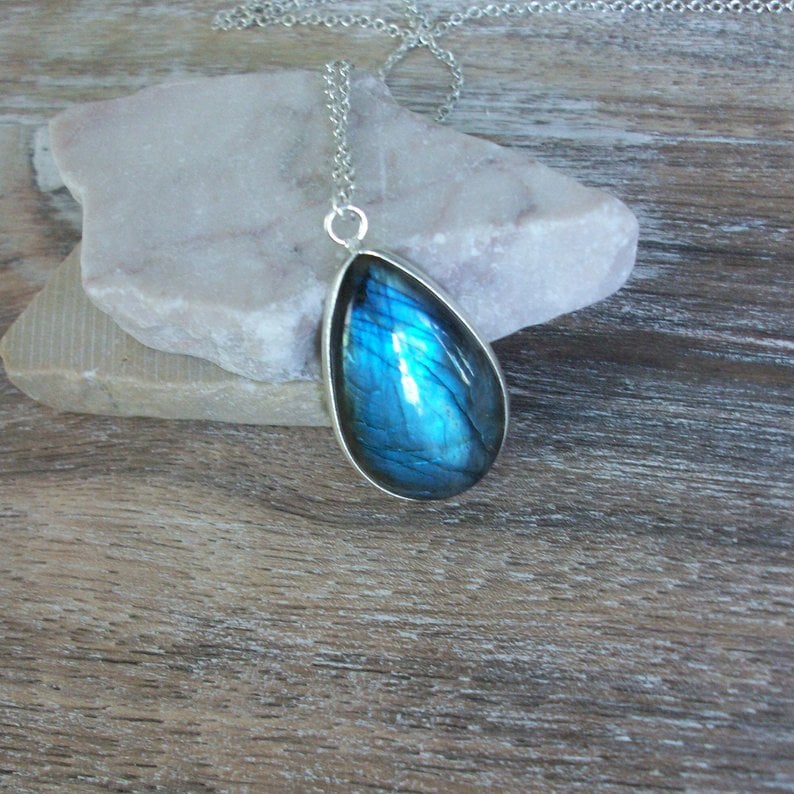
Labradorescence is the unique optical effect characterized by vivid iridescent colors that play across the surface of this gemstone, especially when it’s moved under a source of light. The range of colors can include blue, green, yellow, orange, and sometimes even shades of pink or purple.
Labradorescence isn’t due to any pigmentation within the stone. Instead, it’s caused by the interference of light within the micro-thin layers of the mineral. As light enters the stone, it’s refracted, or bent, between the different layers of minerals within the stone.
The refracted light waves then interfere with each other. This interference causes the light waves to reinforce some colors and diminish others, depending on the thickness and spacing of the layers. The reinforced colors are then reflected back to the eye, producing the vivid displays we associate with labradorescence.

The specific colors and brightness of labradorescence can vary based on the thickness and spacing of the mineral layers in the labradorite, as well as the angle of light incidence and observation.
Labradorescence isn’t the same as iridescence, even though both phenomena involve the play of colors. Iridescence is a broader term that refers to any play of color caused by interference effects in light, and it can be seen in many other minerals, gemstones, and even items like soap bubbles or peacock feathers. Labradorescence, on the other hand, specifically refers to the color play in labradorite.
The 4 C’s of Labradorite
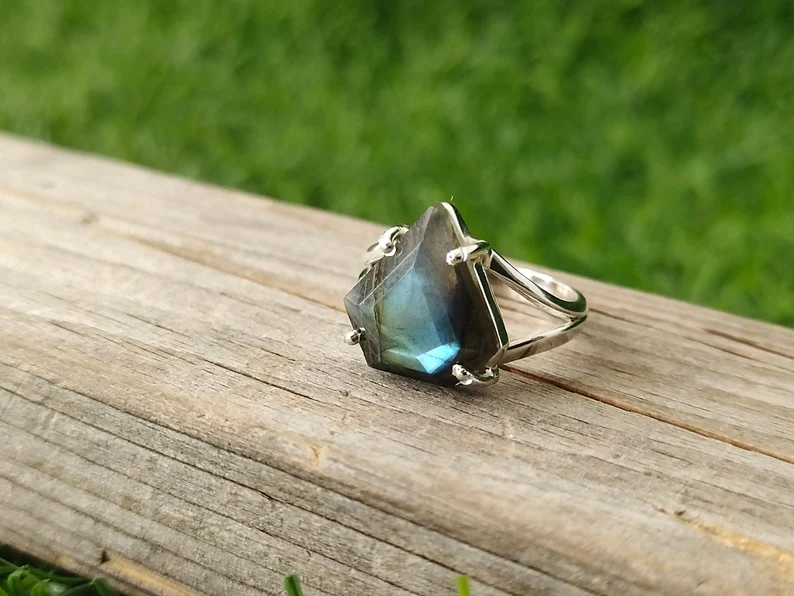
1. Labradorite Color
The body tone of labradorite is usually gray, black or dark brown with labradorescence of greens, blues, and purples. Spectrolite displays the Schiller effect with flashes of colors such as blue, green, red, orange and yellow.
Interestingly, the colors displayed by a labradorite aren’t actually present in the stone, as in most other colored gemstones. Instead, it’s the effect of light reacting with the imperfections within the mineral.
2. Labradorite Clarity

When it comes to gemstones, inclusions or impurities found within the stone are often seen as flaws and devalues the gemstone. However, for labradorites, it’s the miniscule impurities that allow its play of color. As the light hits the layers of tiny impurities, it allows the spectral colors to show.
Most labradorite stones are opaque to translucent, but there are also transparent varieties. Opaque labradorites don’t display as much labradorescence. For this reason, translucent stones are highly sought after. Transparent labradorites are not very desirable as they do not display the distinguishing labradorescence.
3.Labradorite Cut

If labradorites are cut expertly and carefully, the iridescence can be maximized. As the stone is made up of layers of rock, the stone needs to be carefully cut so that the full color is displayed face-up and center.
Labradorites are generally cut into beaded cabochons with smooth domes. If the labradorite is transparent, it is usually faceted to enhance sparkle. You will typically find labradorite cut into rounds, ovals, pears and marquise and not so much in angular cuts.
4. Labradorite Carat Weight
Labradorite can be found in many sizes. Because it’s an affordable stone, the size does not affect value as much as some other gemstones. The size you choose depends on your preferences.
Most retailers highlight the width and length of the labradorite, i.e. the size, rather than the carat weight. This gives you an exact measurement of the stone’s size. This is a more helpful way to measure gemstones because carat weight is relative to the density of the stone, which varies from gemstone to gemstone.
Enhanced or Treated Labradorite

Labradorite, like many gemstones, can undergo treatments or enhancements to improve its appearance or durability. However, labradorite is typically less frequently treated compared to some other gems. Here are some potential treatments that could be applied:
- Polishing: One of the most common “treatments” is simply polishing the stone to highlight its labradorescence. A polished surface can greatly enhance the stone’s natural play of color.
- Stabilization: Some labradorite might be stabilized with a resin or another substance to improve its durability, especially if it has fractures or is porous.
- Coating: On rare occasions, labradorite might be coated with a thin film to enhance its color or iridescence. However, coatings can wear off over time or with exposure to certain chemicals.
Labradorite Jewelry

Labradorite lends itself well to most jewelry applications. It can energize your wardrobe and add an intriguing play of color to your look. Labradorite looks beautiful set in any metal type, but is especially attractive and prominent when set in yellow or rose gold. These metal colors perfectly complement the bluish-greenish hues of labradorite for a classy, chic look.
Due to its affordability, labradorite is a popular choice for costume jewelry. It makes for intriguing large pieces, especially statement necklaces and large cocktail rings.

A great way to highlight your labradorite is through a classy pair of earrings. Whether you go for dangle earrings or simple studs, these will suit any occasion and add a touch of sophistication to your outfit. Labradorite dangle earrings are ideal for dressy evening occasions because they catch and play with light beautifully. This feature gives that extra sparkle and sheen to your look.
Statement rings made from labradorite can be very eye-catching and stand out, especially because these stones come in large sizes. If pendants are more your thing, labradorite pendants are ideal for daily jewelry. Choose a small pendant for daily casual or work wear to complete your outfit.
Is a Labradorite Engagement Ring a Good Idea?

Labradorite engagement rings are an unconventional choice, revered for their unique iridescent play of colors, often referred to as “labradorescence.” This gemstone showcases hues of blue, green, yellow, and even orange or pink, making each piece truly one-of-a-kind.
However, Labradorite is softer than traditional engagement stones like diamonds, sapphires, or rubies, with a Mohs hardness of 6-6.5. This means it’s more susceptible to scratches and may require extra care to maintain its luster over time.
For couples seeking a distinctive and mystical aesthetic, Labradorite can be a meaningful choice. Its durability should be considered, especially for those leading active lifestyles or seeking longevity from their engagement ring.
Cleaning and Caring for Labradorite

Cleaning and caring for labradorite properly will help maintain its iridescent beauty and prolong its life. Here are some steps and tips for cleaning and caring for your labradorite gemstone:
- Mild Soap and Water: Use lukewarm water mixed with a mild soap. Gently scrub the stone with a soft-bristled toothbrush or cloth.
- Rinse and Dry: Rinse the stone thoroughly to remove any soap residue. Dry with a soft cloth to avoid water spots.
- Harsh Chemicals: Don’t use ultrasonic cleaners, steam cleaners, or harsh chemicals as they can damage the stone.
- Abrasive Materials: Avoid scrubbing with anything abrasive, which can scratch the surface of the labradorite.
- Storage: Store your labradorite jewelry separately to avoid contact with harder gemstones or metals that might scratch it. Using a soft cloth bag or a separate compartment in your jewelry box can be ideal.
- Avoid Physical Shocks: Given its relative softness, avoid knocking or dropping labradorite on hard surfaces.
- Limit Sun Exposure: Prolonged exposure to direct sunlight may cause the stone’s color to fade over time.
- Avoid Extreme Temperatures: Sudden temperature changes can be harmful. Try to keep the gemstone away from extreme heat or cold.
- Wear with Care: If you have a labradorite ring, consider removing it during physical activities or tasks that might expose it to harsh chemicals or potential blows.
- Re-polishing: Over time, if your labradorite loses its shine due to scratches or wear, consider having it professionally re-polished.
Labradorite Lore and Symbolism

Labradorite is believed to be a powerful and magical gemstone that can give the wearer intuitive powers and promote psychic abilities. It is also thought to strengthen the imagination and to calm fears and insecurities as well as to relieve stress. It enhances your confidence and sense of worth and for a person with an overactive imagination, labradorite is calming and provides balance.
Labradorite is said to protect you from negativity and ill-will while bringing out the positive aspects of your character. It’s also said to aid in improving the work environment by reducing tension among colleagues and fostering collegiality.

Some believe that labradorite can aid with certain physical illnesses such as colds, respiratory issues, menstrual pain and helps with digestion and metabolism.
In ancient Hindu beliefs, labradorite is connected to the Throat Chakra, which is also called Vishuddha, meaning purification. This Chakra is associated with expression and communication, so wearing labradorite fosters these qualities and assists in maintaining the health of the Throat Chakra.
The Inuit Legend of Labradorite

The Inuit peoples, native to the Arctic regions of Canada, Greenland, and Alaska, have an enchanting tale associated with labradorite.
The Inuit legend holds that the Northern Lights, also known as the Aurora Borealis, were once captured within the rocks along the coast of Labrador, a region in Canada. It was believed that an Inuit warrior found these trapped lights and tried to free them by striking the rocks with his spear. Most of the lights ascended into the sky, but some remained entrapped in the stones, which is how labradorites came to possess their characteristic vibrant sheen.

This tale beautifully encapsulates the ethereal glow of labradorite, drawing a poetic parallel between the magical dance of the Northern Lights in the Arctic skies and the shifting colors seen in the stone. To the Inuit, the stone’s labradorescence isn’t just a play of colors but a visual reminder of their ancestral legends and the mysteries of the universe. This connection between nature, myth, and spirituality underscores the significance of labradorite in Inuit culture, making it more than just a gemstone but a tangible piece of their rich heritage.
Where Can I Buy a Labradorite Jewelry?

It may be difficult to find labradorite in most physical stores because surprisingly, it’s not a mainstream gemstone. Taking your search online will give you endless options to choose from.
When buying online, ensure that you are buying from a top-rated vendor with a proven track record. We recommend starting your search on Etsy and Amazon as these platforms have endless options to suit various budgets and styles.
Etsy
For those that want something more special, unique, and handmade, Etsy has a huge assortment of vendors that offer a variety of all types of labradorite jewelry. Their labradorite jewelry ranges from a few dollars to pieces that costs thousands of dollars. Browse Etsy here.
Amazon
As it is one of the biggest online retailers worldwide, it’s not surprising that you can find all kinds of labradorite jewelry here. The range is extensive and will take some time to go through, but it’s well worth it. Search Amazon here.
Of course, since every vendor on Etsy and Amazon have their own policies and rules you might need to do a bit more digging and research, but that’s ultimately worth it in the end when you manage to find the perfect labradorite jewelry. Use the site’s extensive rating and review sections to gauge the quality of each product.
Wrapping Up
Labradorite jewelry, with its mesmerizing play of colors, captivates the beholder, evoking images of ethereal landscapes and celestial phenomena. Beyond its beauty, it carries with it the weight of legends, such as the Inuit tales of trapped Northern Lights. Whether set in a ring, pendant, or earrings, this gem is a conversation starter and a statement of individuality.



